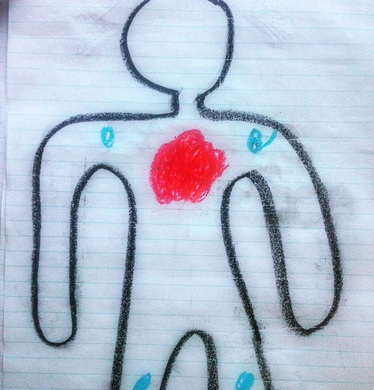 Conflicts at home are all too common with the families I work with. This morning, just a few days before our holiday break, I had a session with a young boy after he had recently stolen from a family member. I was unaware of this event prior to the session but he told me during our check in while completing the Outcome Rating Scale. When asked how he is doing emotionally, he answered with the words guilt and shame. Last week I wrote about using the right hemisphere of the brain during therapy sessions so when this important event presented itself, we pulled out the oil pastels and some paper. His task, to draw what this guilt feels like on the inside. Where no one can see it. During sessions with children I try to teach them about the safety of the present moment. I try to make my office into a small sanctuary away from the real life, natural consequences of everyday life. This security allows us to explore difficult past experiences with feelings of peace and serenity. The 11-year-old boy’s finished project, pictured above, showed a fiercely drawn red circle in the centre of the body with four small blue dots at each limb. The red represented a feeling of fire in his chest that made him feel a whole range of emotions like anger, sadness, anxiety about what will happen and regret. He told me that when confronting what he had done, he felt immobilised. It was as if he could not move his arms or legs. I assured him that this guilt was normal. He had done something he knew was wrong and regretted. Worry about this scenario would come if his guilt turned inward and he began to feel shame, or feeling bad about himself. Guilt is a fairly natural response to doing something that we feel is wrong or that in which we could avoid. An appropriate level of guilt should protect us from repeating the undesired behaviour and motivates us to repair any pain we may have caused to those around us. Shame, on the other hand, can motivate us towards denying, hiding or blaming others. The general rule of thumb for avoiding this shame is to remember that there is only one good kind of guilt. That is guilt about something you did. A specific behaviour. It can be hard to do in the moment but if we can tune in to the specific thing we did then a lot of the background noise should diminish. Guilt about things you think you should have done, something you are unable to do or guilt about feeling as though you are better off than someone else are easy roads towards shame. The goal to this balance is to be really specific about why the feeling is arising and how justified it is. If you can label the explicit behaviour that you feel is wrong then its time to make a change. If you need to address it with your loved one or coworker then do it. If you need to talk to someone to get some tips or tricks on how to avoid repeating the behaviour than go out and find the right person for you. You can’t go back and change what you’ve done but you can make a better moment in the present and feel hopeful for the future. Have a safe and happy new year. Will Dobud, MSW 0477161768 [email protected]
0 Comments
Leave a Reply. |
Contact WillE: [email protected] Archives
September 2019
Categories |
 RSS Feed
RSS Feed
